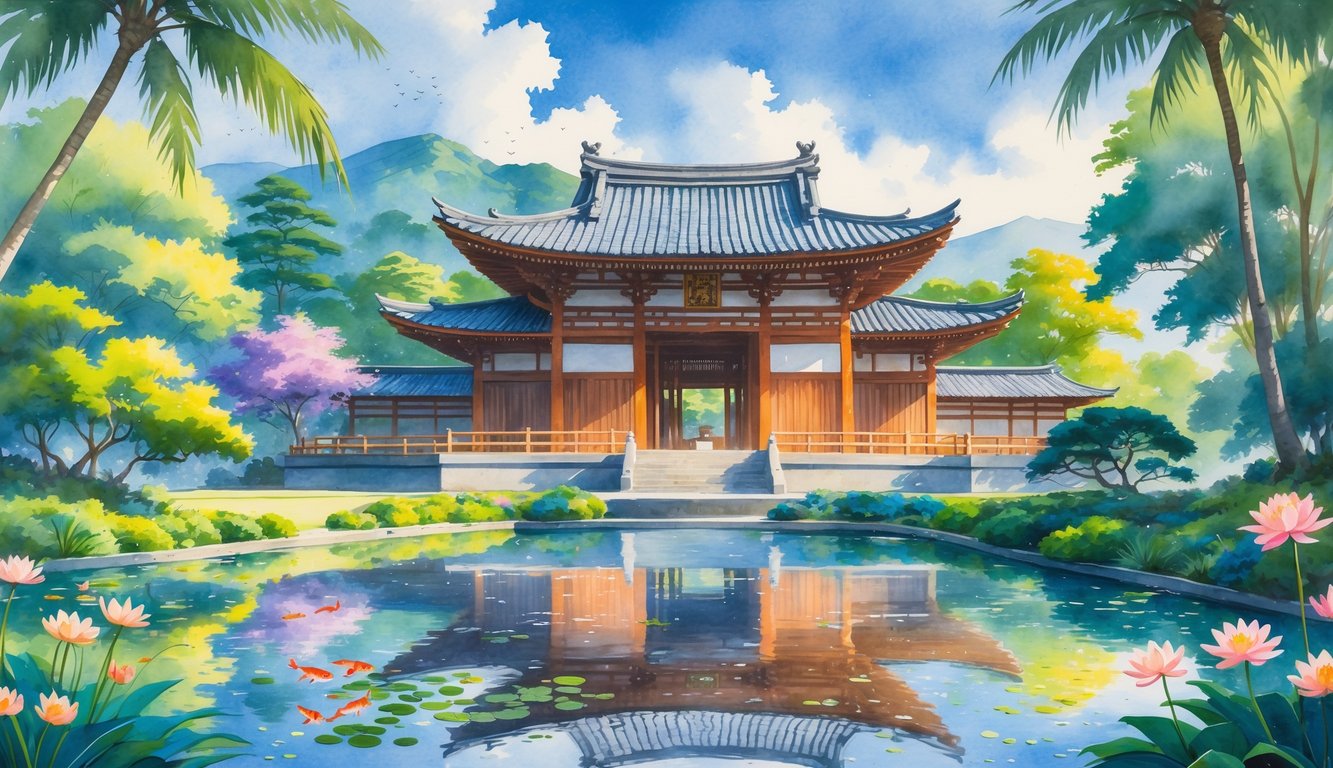Tucked away at the foot of the Koʻolau Mountains, the Byodo-In Temple in Oahu offers a peaceful escape from the island’s busier spots.

Builders completed the temple in 1968 to honor the 100th anniversary of Japanese immigration to Hawaii.
It stands as a non-practicing Buddhist temple that welcomes people of all faiths.
Visitors can explore stunning architecture, learn about cultural history, and enjoy a serene setting in one visit.

Lush gardens, koi ponds, and the gentle sound of a large temple bell create a tranquil atmosphere.
The temple replicates a 950-year-old temple in Uji, Japan, but fits perfectly into its Hawaiian landscape.
Its location inside the Valley of the Temples Memorial Park makes it easy to visit along with other scenic stops on Oahu’s east side.
People come to admire the golden Amida Buddha, feed the koi, or take in the mountain views.
The Byodo-In Temple lets visitors connect with Japanese heritage and Hawaiian beauty in a calm and memorable way.
Visiting the Byodo-In Temple: Location and Setting

The Byodo-In Temple sits at the base of the Ko’olau Mountains in Kaneohe.
Its spot inside the Valley of the Temples Memorial Park offers a scenic setting with lush greenery and reflective ponds.
Visitors enjoy both the temple’s architecture and the natural beauty of the area.
Getting to the Temple in Kaneohe
The temple stands on Oahu’s windward side in the town of Kaneohe.
It is about a 30–40 minute drive from Honolulu, depending on traffic.
Most people arrive by car, as no direct public bus route goes into the Valley of the Temples Memorial Park.
Parking is free inside the park.
Popular driving routes include the H-3 Freeway, which passes through mountain tunnels, and the Likelike Highway, which offers ocean and mountain views.
Both routes lead into Kaneohe before turning toward the park entrance.
If you use GPS, enter “Byodo-In Temple Hawaii” to get the exact location.
The address is clearly marked at the park entrance.
Ko’olau Mountains and Valley of the Temples Memorial Park
The Ko’olau Mountains rise steeply behind the temple, often with clouds drifting across the peaks.
The temple sits within the Valley of the Temples Memorial Park, a landscaped cemetery and memorial site.
The grounds have paved paths, koi ponds, and shaded areas for rest.
Wildlife such as black swans and koi fish swim in the ponds.
This location offers a peaceful setting and a close connection to nature.
The park contains memorials for many faiths, but the Byodo-In Temple is its most recognized landmark.
Admission, Hours, and Accessibility
Private owners manage the temple and charge a small admission fee.
Adult tickets are around $5, with reduced rates for children and seniors.
Usual hours are 9:00 AM to 5:00 PM, but visitors should check current times before arriving.
The last entry is usually 30 minutes before closing.
The grounds are mostly accessible for wheelchairs and strollers.
Paved walkways and ramps make it easy to get around, and benches are placed throughout for resting.
For more details, travelers can check the official Byodo-In Temple Hawaii website.
History and Cultural Significance

The Byodo-In Temple in Oahu closely replicates a historic Buddhist temple in Uji, Japan.
It honors Hawaii’s Japanese heritage and reflects centuries-old architectural traditions that value harmony, respect, and peace.
Origins and Construction
The temple follows the design of the Byodo-In Temple in Uji, Japan, a UNESCO World Heritage Site over 950 years old.
Construction began in 1968 under architect Masuzo Inui, who designed the structure to mirror the original’s Phoenix Hall.
Craftsmen used traditional Japanese joinery and built the temple without nails.
This method preserved the authentic design and highlighted their skill.
The Hawaiian replica sits in the Valley of the Temples in Kāneʻohe, surrounded by gardens and koi ponds.
Planners designed every element, from the bridge to the meditation areas, for quiet reflection.
Commemorating Japanese Heritage in Hawaii
The temple’s construction marked the 100th anniversary of the first Japanese immigrants’ arrival to Hawaii in 1868.
It serves as a cultural bridge between Japan and Hawaii, symbolizing the contributions of Japanese immigrants to the islands’ communities.
Local leaders and Japanese dignitaries attended the dedication ceremony.
Today, the temple welcomes visitors of all backgrounds and offers a chance to learn about Japanese traditions.
For more about its historical background, see this detailed overview of the Byodo-In Temple.
Temple of Equality and Traditions
The name “Byodo-In” means “Temple of Equality – not to discriminate.”
This name reflects Buddhist values of compassion and fairness.
Inside, a large golden statue of the Buddha Amida sits as the focal point.
Smaller carvings around the statue show bodhisattvas in graceful poses.
Visitors often ring the bon-sho (sacred bell) before entering.
This act helps clear the mind and prepare for meditation.
Seasonal ceremonies, such as Obon and New Year’s celebrations, connect the temple to its Japanese roots and the local Hawaiian community.
Learn more about its symbolic meaning at this Byodo-In Temple guide.
Architectural Features and Sacred Sites
The Byodo-In Temple in Hawaii blends Japanese craftsmanship with peaceful natural surroundings.
Visitors see detailed recreations of historic architecture, admire sacred art, and walk through gardens that reflect centuries-old traditions.
Phoenix Hall and Traditional Japanese Design
The Phoenix Hall stands as the centerpiece of the Byodo-In Temple Hawaii.
It follows the design of the original 11th-century hall in Uji, Japan.
Curved, tiled roofs with upward-sweeping eaves give the building a balanced look.
Two phoenix statues on the roof represent protection and renewal.
The hall faces a large reflecting pond, creating a mirror-like view that changes with the light.
Inside, the design uses open spaces, natural wood tones, and minimal decoration to encourage calm reflection.
Visitors can walk around the exterior to see the intricate joinery and details built without nails.
This technique is a classic feature of Japanese carpentry.
For more on its history and design, see the Byodo-In Temple overview.
The Amida Buddha Statue
At the heart of the Phoenix Hall sits the Amida Buddha statue, a symbol of compassion and enlightenment in Pure Land Buddhism.
This statue stands nearly 9 feet tall and is covered in gold leaf, which gives it a soft, warm glow.
It is a smaller-scale reproduction of the original in Japan, but made with equal attention to detail.
The figure sits in the lotus position with hands in the mudra gesture of meditation.
Carved wooden panels around the statue show celestial beings.
Each figure is positioned to guide worshippers toward peace.
Visitors often pause here for quiet moments.
The stillness and the scent of incense add to the sense of reverence.
More details can be found at Byodo-In Temple Hawaii.
Koi Ponds and Japanese Gardens
Large koi ponds with colorful fish surround the Phoenix Hall.
These ponds reflect both the building and the nearby Koʻolau Mountains.
Bridges cross over the water, offering close views of koi swimming among water lilies.
Feeding stations let visitors give the fish small pellets, which is a favorite activity for families.
The gardens follow Japanese landscaping principles with carefully placed stones, trimmed shrubs, and winding paths.
Seasonal flowers add color, and small waterfalls bring the sound of moving water.
Together, the ponds and gardens create a quiet environment that matches the temple’s architecture.
You can explore more about the grounds at Explore the Byodo-In Temple.
Experiences and Activities at the Temple
Visitors can take part in hands-on activities that highlight the temple’s cultural and spiritual traditions.
These experiences encourage reflection and connection with nature.
Ringing the Bon-sho Sacred Bell
The large bon-sho bell stands in its own wooden structure near the entrance.
Craftsmen in Japan cast this sacred bell, which is over six feet tall and weighs nearly three tons.
Guests may ring the bell before entering the temple grounds.
The act produces a deep, resonant tone that lasts for several seconds.
Traditionally, the sound clears the mind of distractions.
Many visitors pause to listen as the tone fades, using the moment to set a calm mindset for their visit.
The bell’s surface shows intricate inscriptions and symbolic designs.
Staff encourage visitors to strike it gently with the suspended wooden log.
Meditation Pavilion and Peaceful Spaces
A meditation pavilion sits in a quiet corner of the grounds.
This open-air structure offers views of the koi ponds, gardens, and surrounding mountains.
Benches and floor mats provide space for seated reflection.
Some visitors practice silent breathing exercises, while others simply sit and observe the scenery.
Natural breezes pass through the pavilion, adding to the tranquil atmosphere.
Early mornings are especially calm, with fewer people and softer light.
Nearby shaded areas and small stone benches offer more peaceful spots.
These spaces invite unhurried moments to read, think, or enjoy the sound of water in the gardens.
Wildlife and Tranquil Walks
Colorful koi, black swans, and small wild birds live on the temple grounds. Visitors often see fish gather near the bridges, where they feed them with purchased koi food.
Walking paths wind around the ponds and landscaped gardens. The short and easy routes suit all ages.
Guests can spot turtles sunning themselves on rocks. They might also hear the calls of native birds.
Water features, plants, and wildlife create a relaxing environment. This setting encourages slow, mindful walking.
For more details on the setting and location, see the Byodo-In Temple in Oahu.




